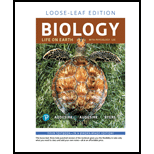
Pearson eText Biology: Life on Earth with Physiology -- Instant Access (Pearson+)
12th Edition
ISBN: 9780135755785
Author: Gerald Audesirk, Teresa Audesirk
Publisher: PEARSON+
expand_more
expand_more
format_list_bulleted
Concept explainers
Question
Chapter 33.5, Problem 1CSC
Summary Introduction
To determine:
The function of lymphatic system other than absorbing all the intestinal fluid that leaks from capillaries and return it to bloodstream.
Introduction:
Lymphatic system is the network of tissue and organs that help in removing the toxic substances from the body and also acts as a circulatory system that helps in the draining of fluid from the vessels. The lymphatic system is made up of network of lymphatic vessels and secondary lymphoid organs.
Expert Solution & Answer
Want to see the full answer?
Check out a sample textbook solution
Students have asked these similar questions
What is the structure and function of Eukaryotic cells, including their organelles? How are Eukaryotic cells different than Prokaryotic cells, in terms of evolution which form of the cell might have came first? How do Eukaryotic cells become malignant (cancerous)?
What are the roles of DNA and proteins inside of the cell? What are the building blocks or molecular components of the DNA and proteins? How are proteins produced within the cell? What connection is there between DNA, proteins, and the cell cycle? What is the relationship between DNA, proteins, and Cancer?
Why cells go through various types of cell division and how eukaryotic cells control cell growth through the cell cycle control system?
Chapter 33 Solutions
Pearson eText Biology: Life on Earth with Physiology -- Instant Access (Pearson+)
Ch. 33.1 - Why doesnt insect hemolymph need hemoglobin?Ch. 33.1 - Prob. 1CYLCh. 33.1 - compare open and closed circulatory systems?Ch. 33.1 - describe the functions of the vertebrate...Ch. 33.2 - Prob. 1CSCCh. 33.2 - Prob. 1TCCh. 33.2 - Prob. 1HYEWCh. 33.2 - describe the three types of vertebrate hearts and...Ch. 33.2 - Prob. 2CYLCh. 33.2 - Prob. 3CYL
Ch. 33.3 - Prob. 1TCCh. 33.3 - Prob. 2TCCh. 33.3 - describe each component of blood and explain its...Ch. 33.3 - Prob. 2CYLCh. 33.3 - explain the sequence of events during blood...Ch. 33.4 - Prob. 1TCCh. 33.4 - Prob. 2TCCh. 33.4 - Prob. 1CYLCh. 33.4 - Prob. 2CYLCh. 33.4 - Prob. 3CYLCh. 33.5 - Prob. 1TCCh. 33.5 - Prob. 1CSCCh. 33.5 - Prob. 1CYLCh. 33.5 - Prob. 2CYLCh. 33.5 - Prob. 3CYLCh. 33 - Prob. 1MCCh. 33 - Which of the following is True? a. Arteriole...Ch. 33 - Prob. 3MCCh. 33 - Prob. 4MCCh. 33 - Which of the following is true of blood pressure?...Ch. 33 - Prob. 1FIBCh. 33 - Prob. 2FIBCh. 33 - The hearts pacemaker is called the (complete term)...Ch. 33 - Prob. 4FIBCh. 33 - Prob. 5FIBCh. 33 - Prob. 6FIBCh. 33 - Lymph is ___________ that has entered lymphatic...Ch. 33 - List the major structures of all circulatory...Ch. 33 - Describe and compare the features of open and...Ch. 33 - Explain how two- and three-chambered vertebrate...Ch. 33 - Prob. 4RQCh. 33 - Prob. 5RQCh. 33 - Prob. 6RQCh. 33 - Prob. 7RQCh. 33 - Prob. 8RQCh. 33 - Describe the cardiac cycle, and relate the...Ch. 33 - Prob. 10RQCh. 33 - Prob. 11RQCh. 33 - Prob. 12RQCh. 33 - In what way do veins and lymphatic vessels...Ch. 33 - Prob. 1ACCh. 33 - Prob. 2AC
Knowledge Booster
Learn more about
Need a deep-dive on the concept behind this application? Look no further. Learn more about this topic, biology and related others by exploring similar questions and additional content below.Similar questions
- In one paragraph show how atoms and they're structure are related to the structure of dna and proteins. Talk about what atoms are. what they're made of, why chemical bonding is important to DNA?arrow_forwardWhat are the structure and properties of atoms and chemical bonds (especially how they relate to DNA and proteins).arrow_forwardThe Sentinel Cell: Nature’s Answer to Cancer?arrow_forward
- Molecular Biology Question You are working to characterize a novel protein in mice. Analysis shows that high levels of the primary transcript that codes for this protein are found in tissue from the brain, muscle, liver, and pancreas. However, an antibody that recognizes the C-terminal portion of the protein indicates that the protein is present in brain, muscle, and liver, but not in the pancreas. What is the most likely explanation for this result?arrow_forwardMolecular Biology Explain/discuss how “slow stop” and “quick/fast stop” mutants wereused to identify different protein involved in DNA replication in E. coli.arrow_forwardMolecular Biology Question A gene that codes for a protein was removed from a eukaryotic cell and inserted into a prokaryotic cell. Although the gene was successfully transcribed and translated, it produced a different protein than it produced in the eukaryotic cell. What is the most likely explanation?arrow_forward
- Molecular Biology LIST three characteristics of origins of replicationarrow_forwardMolecular Biology Question Please help. Thank you For E coli DNA polymerase III, give the structure and function of the b-clamp sub-complex. Describe how the structure of this sub-complex is important for it’s function.arrow_forwardMolecular Biology LIST three characteristics of DNA Polymerasesarrow_forward
arrow_back_ios
SEE MORE QUESTIONS
arrow_forward_ios
Recommended textbooks for you






12 Organ Systems | Roles & functions | Easy science lesson; Author: Learn Easy Science;https://www.youtube.com/watch?v=cQIU0yJ8RBg;License: Standard youtube license